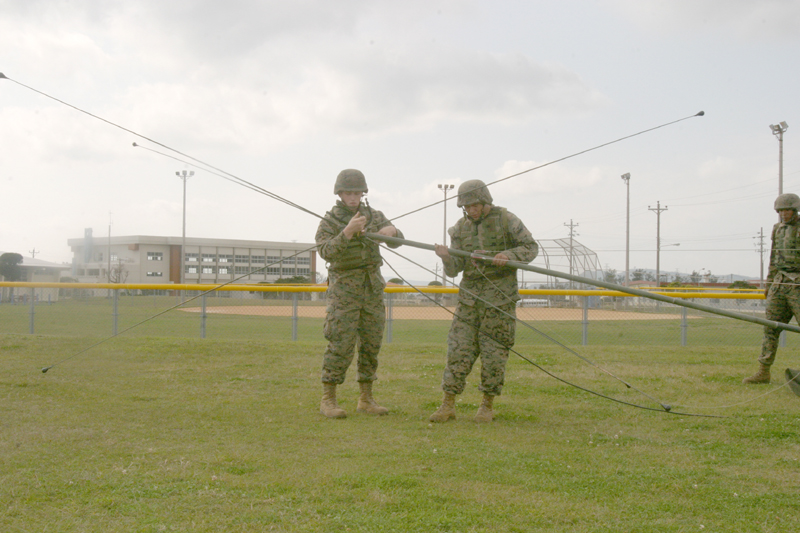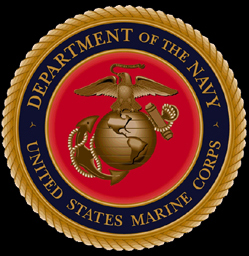
Marines prepare to raise an OE254 radio antenna here Jan. 25. The antenna can receive radio signals from 10 to 24 miles away on land. Twenty-eight Marines with Radio Platoon, 12th Marine Regiment, 3rd Marine Division, tested their communications gear in preparation for exercise Cobra Gold '05
12th MARINES GET WIRED
LANCE CPL. BRANDON R. HOLGERSEN
CAMP HANSEN (Feb 4, 2005) -- A row of a dozen antennas and a satellite occupy a small area of a grassy hill.
To a casual observer, it may look like someone is trying to pick up radio signals from alien life forms, but in reality it was 28 Marines with Radio Platoon, 12th Marine Regiment, 3rd Marine Division, testing their communications gear here Jan. 25 in preparation for exercise Cobra Gold '05.
The Marines must break down, clean and test all their gear before deploying to Thailand to ensure they can properly set up their equipment, according to Lance Cpl. Kyle D. Adams, a multi-channel, ultra-high-frequency transmissions chief with the platoon.
When the unit reaches Thailand, they will have to supply phones, Internet capabilities and radio to an entire base, and it is important they rehearse setting up and testing their gear, according to Adams.
"This is practice so that when it's time for us to use and set up our equipment, it becomes second nature," said Sgt. Christopher J. Gebo, the platoon's noncommissioned officer-in-charge.
The Marines practiced setting up OE254 radio antennas, which are connected to radios. The Marines also set up a multi-channel, ultra-high-frequency antenna that is used to relay data for commercial phone lines, secured and unsecured Internet.
"The hardest part of hooking up all the phones and radios is making sure you have a connection," said Lance Cpl. Nick M. Bodyk, a field radio operator with the platoon. "You have to go through every set of wires and make sure they are connected properly."
Marines received a signal from another set of antennas set up about 100 yards away to test their gear. Then they relayed the messages via wire to a simulated combat operations center set up in a high mobility multipurpose wheeled vehicle. Finally, they radioed back to the source of the signal and confirmed that the signals were received, according to Adams.
The Marines also connected radios to switchboards so they could use their radios to call a commercial phone line, according to Lance Cpl. Michael J. Breen, a switchboard operator with the platoon.
Being able to connect to a commercial phone line from a radio can help a command stay better connected, and it can also be good for morale, according to Adams.
"In the field, you might have someone whose spouse is having a baby and he just needs to talk to her for a minute," Adams said. "We can provide a phone call home for people in the field for important matters."
Practicing setting up phone lines, antennas, Internet connections, radios and satellites can take anywhere from a week to a month to get ready for an exercise, according to Adams.
"We test all our radio assets before we go anywhere," said Cpl. Mike C. Phelane, a switchboard operator with the platoon. "We test whatever we think we might need out there."
Communications gear is essential to any operation or exercise, according to Doyle.
"If you have rounds going down range, how would you know if they were impacting in the right place if you didn't have communication?" Doyle asked.
PAUL MARQUIS
WEB MASTER

THE SCUTTLEBUTT
